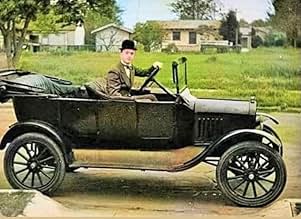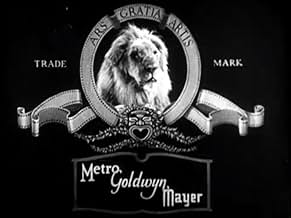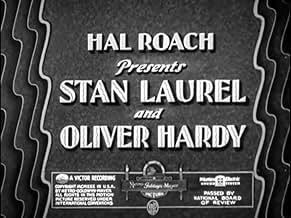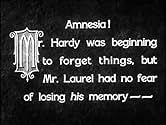AVALIAÇÃO DA IMDb
7,4/10
2,3 mil
SUA AVALIAÇÃO
Adicionar um enredo no seu idiomaOllie can't find his hat, much to the amusement of his wife and maid. Then Ollie and Stan attempt to install a rooftop radio antenna.Ollie can't find his hat, much to the amusement of his wife and maid. Then Ollie and Stan attempt to install a rooftop radio antenna.Ollie can't find his hat, much to the amusement of his wife and maid. Then Ollie and Stan attempt to install a rooftop radio antenna.
- Direção
- Roteiristas
- Artistas
Russell Custer
- Bus Passenger
- (não creditado)
Betty Danko
- Bus Passenger
- (não creditado)
Dorothy Granger
- Tillie - The Hardys' Maid
- (não creditado)
- …
Fay Holderness
- Mrs. Hardy
- (não creditado)
Charles McMurphy
- Streetcar Conductor
- (não creditado)
Cy Slocum
- Bus Passenger
- (não creditado)
Joy Winthrop
- Bystander
- (não creditado)
Avaliações em destaque
After having seen just about every short Laurel and Hardy made together, I have noticed that the most of the best films are the ones with very simple and mundane plots. Films such as DIRTY WORK, HELP MATES and HOG WILD simply have the pair cleaning house or fixing things, yet they sure milk it for all its worth. I think one of the reasons I love these films is that they aren't cluttered with co-stars or difficult plots and just allow the pair to be the lovable and klutzy characters we've come to love.
Here, Ollie's wife tells him to install a radio aerial on the roof so they can get better reception and THEN he can go have fun with Stan. For any halfway normal person, this would have been a rather quick job--and so naturally the boys nearly kill themselves as well as manage to destroy much of the house! The film ends with a tough to believe but well-filmed sequence where Ollie is stuck on a ladder and Stan accidentally starts the car. Unlike lousy driving sequences such as in COUNTY HOSPITAL where the studio used cheap and unrealistic rear projection to make the driving sequence, here it's filmed for real--though of course stunt doubles were used for the distant shots. This scene and the final shot were quite well done and worked well with the prior house demolition scenes--providing many laughs and no serious lulls. Funny and right to the point.
Here, Ollie's wife tells him to install a radio aerial on the roof so they can get better reception and THEN he can go have fun with Stan. For any halfway normal person, this would have been a rather quick job--and so naturally the boys nearly kill themselves as well as manage to destroy much of the house! The film ends with a tough to believe but well-filmed sequence where Ollie is stuck on a ladder and Stan accidentally starts the car. Unlike lousy driving sequences such as in COUNTY HOSPITAL where the studio used cheap and unrealistic rear projection to make the driving sequence, here it's filmed for real--though of course stunt doubles were used for the distant shots. This scene and the final shot were quite well done and worked well with the prior house demolition scenes--providing many laughs and no serious lulls. Funny and right to the point.
At a time when Harold Lloyd, Buster Keaton, and other great silent comedy stars were struggling to deal with the new technology of sound recording, Laurel & Hardy were doing some of the best work of their career simply by continuing to make the sort of movie they'd been making all along. Hog Wild, a highly enjoyable talkie short released in the spring of 1930, is a case in point. The premise is that the boys must install the Hardys' new radio aerial on the roof before Mrs. Hardy will allow them to go out-- it seems that she wants to "get Japan" --and needless to say, the work doesn't go all that smoothly. Just the sight of these guys setting up a ladder on the back of Mr. Laurel's car is enough to get the chuckles started. But where film-making technique is concerned the team could have made substantially the same movie as a silent short a year or two earlier without changing much. Most of the action, after all, consists of sight gags and slapstick up on the roof of the Hardy home, topped with a wild ride in a runaway car through the streets of Culver City, one of L&H's all-time best finales. Dialog is kept to a minimum, and what dialog there is between Stan and Ollie and Ollie's wife is simple and straightforward, without any of the strained wisecracks we hear in some other early talkies featuring other performers.
But although the material is primarily visual, I'm glad this film was made with sound for a couple of reasons. Ollie and his wife (Fay Holderness) have a spirited verbal tiff at the beginning concerning the whereabouts of Ollie's hat, and this sequence wouldn't be nearly as effective if we were reading the dialog on title cards. Oliver Hardy had a terrific voice, and he uses it to nice effect in this exchange, blasting his wife with heavy sarcasm . . . until he realizes that the hat in question has been sitting on his own head all along, at which point -- after directing one of his patented 'looks' into the camera -- he attempts to brazen it out by claiming he's just found the hat under the bed! Stan Laurel doesn't speak much here, but as ever the contrast between his soft Lancashire accent and Ollie's earthier tone achieves a mysteriously perfect blend. The boys were lucky; Lloyd and Keaton had voices that didn't seem to suit their looks, and limited what they could do in talkies, while Stan and Ollie were blessed with voices that suited their screen characters perfectly and guaranteed they would thrive in the new medium. The other reason I'm glad Hog Wild has a soundtrack is that this movie features some of the liveliest L&H musical themes, those incredibly catchy little tunes so familiar from the Hal Roach comedies of the '30s. The scenes of Stan and Ollie puttering away on the roof (and plummeting to the ground) are just made for this music, which serves as icing on the cake for their fans.
Hog Wild is a real treat, and that climactic sequence with the car, the ladder, and the double-decker bus can hold its own with the funniest and best-edited chase sequences devised by any of Laurel & Hardy's contemporaries.
But although the material is primarily visual, I'm glad this film was made with sound for a couple of reasons. Ollie and his wife (Fay Holderness) have a spirited verbal tiff at the beginning concerning the whereabouts of Ollie's hat, and this sequence wouldn't be nearly as effective if we were reading the dialog on title cards. Oliver Hardy had a terrific voice, and he uses it to nice effect in this exchange, blasting his wife with heavy sarcasm . . . until he realizes that the hat in question has been sitting on his own head all along, at which point -- after directing one of his patented 'looks' into the camera -- he attempts to brazen it out by claiming he's just found the hat under the bed! Stan Laurel doesn't speak much here, but as ever the contrast between his soft Lancashire accent and Ollie's earthier tone achieves a mysteriously perfect blend. The boys were lucky; Lloyd and Keaton had voices that didn't seem to suit their looks, and limited what they could do in talkies, while Stan and Ollie were blessed with voices that suited their screen characters perfectly and guaranteed they would thrive in the new medium. The other reason I'm glad Hog Wild has a soundtrack is that this movie features some of the liveliest L&H musical themes, those incredibly catchy little tunes so familiar from the Hal Roach comedies of the '30s. The scenes of Stan and Ollie puttering away on the roof (and plummeting to the ground) are just made for this music, which serves as icing on the cake for their fans.
Hog Wild is a real treat, and that climactic sequence with the car, the ladder, and the double-decker bus can hold its own with the funniest and best-edited chase sequences devised by any of Laurel & Hardy's contemporaries.
Hog Wild concerns Hardy, who wants nothing more than to go out on the town with Laurel until his wife insists that he install a radio antenna atop their roof. Hardy still winds up inviting Laurel over to help him with such a project, which will of course go awry in a multitude of different ways. For starters, the roof begins to fall apart due to the carelessness of the men, and eventually results in an epic (for the time), collision, sending the boys into a complete tailspin of idiocy.
Hog Wild is standard slapstick Laurel and Hardy fare, but it provides for a certain kind of "one thing leads to another" setup that keeps it going longer than if it was just an assortment of gags (which it still is at times). The verbal banter between the two men is downplayed, and the only real kind of situational gag imposed is at the very beginning of the film, where Hardy is searching for his hat that he is scolding his wife (Fay Holderness) for misplacing when it is already on his head. Certain gags like this feel like cop-outs and deliberate distractions from the fact that the film has nothing going on under its head (sort of like Laurel and Hardy themselves).
The short turns a bit more captivating towards the end, when all hell really starts breaking loose. Laurel and Hardy shorts have a traditional potboiler effect to their drama, where events escalate faster than the audience can keep up in the best way possible. Hog Wild has that effect in a low-key sense, making it at least marginally interesting even if the action and the wit isn't as substantial as it could be. This is a fine, effective short all around, despite lacking in the area that Laurel and Hardy are best in, which is verbal banter and quirky exchanges.
Starring: Stan Laurel, Oliver Hardy, and Fay Holderness.
Hog Wild is standard slapstick Laurel and Hardy fare, but it provides for a certain kind of "one thing leads to another" setup that keeps it going longer than if it was just an assortment of gags (which it still is at times). The verbal banter between the two men is downplayed, and the only real kind of situational gag imposed is at the very beginning of the film, where Hardy is searching for his hat that he is scolding his wife (Fay Holderness) for misplacing when it is already on his head. Certain gags like this feel like cop-outs and deliberate distractions from the fact that the film has nothing going on under its head (sort of like Laurel and Hardy themselves).
The short turns a bit more captivating towards the end, when all hell really starts breaking loose. Laurel and Hardy shorts have a traditional potboiler effect to their drama, where events escalate faster than the audience can keep up in the best way possible. Hog Wild has that effect in a low-key sense, making it at least marginally interesting even if the action and the wit isn't as substantial as it could be. This is a fine, effective short all around, despite lacking in the area that Laurel and Hardy are best in, which is verbal banter and quirky exchanges.
Starring: Stan Laurel, Oliver Hardy, and Fay Holderness.
"Hog Wild" is not only one of Laurel & Hardy's best films, it's simply one of the greatest shorts ever made. Give the boys a simple situation, let 'em milk twenty minutes worth of inspired gags out of it and you have a damn near perfect comedy.
In this 1930s short, Laurel & Hardy are planning to put up an aerial, ("Mrs Hardy wants to get Japan!"). That is all there is to say about the story; what we get is Laurel & Hardy playing with tools, Ollie being pestered by his wife and a hilarious slapstick finale which manages to remain completely in character. With about 18 minutes of pantomime and 2 minutes of dialogue, "Hog Wild" represents Laurel & Hardy at their absolute best. And we know how good that is!
In this 1930s short, Laurel & Hardy are planning to put up an aerial, ("Mrs Hardy wants to get Japan!"). That is all there is to say about the story; what we get is Laurel & Hardy playing with tools, Ollie being pestered by his wife and a hilarious slapstick finale which manages to remain completely in character. With about 18 minutes of pantomime and 2 minutes of dialogue, "Hog Wild" represents Laurel & Hardy at their absolute best. And we know how good that is!
This is one of many Laurel & Hardy short features that show how much mileage the great comedy duo were able to get out of a single situation. After a somewhat slow opening sequence, Stan and Ollie have to install a radio antenna on Ollie's roof, and things quickly get "Hog Wild", as everything that can happen does happen. You can see a lot of the gags coming in this one, but they are still very funny, done cleverly and with expert timing. It gets even better as it goes along. This one is worth making a point to see if you are a fan of Laurel and Hardy.
Você sabia?
- CuriosidadesThe leggy girl lifting her skirt as she attempts to navigate a puddle of water as Stan approaches Ollie's house is Dorothy Granger, who also portrays the Hardys' maid.
- Erros de gravaçãoWhen Stan and Ollie are sitting in the lily pond after the chimney has fallen on them, you can see one of the fake bricks floating in the water.
- Citações
Mrs. Hardy: [runs up to Ollie] Oh Oliver darling, this is terrible.
Ollie: Oh, don't cry over me, dear. I'm not hurt.
Mrs. Hardy: I'm not crying over you. The man came and took the radio away.
[sobs]
- Versões alternativasThere is also a colorized version.
Principais escolhas
Faça login para avaliar e ver a lista de recomendações personalizadas
Detalhes
- Data de lançamento
- País de origem
- Central de atendimento oficial
- Idioma
- Também conhecido como
- A Arte de Instalar Antenas
- Locações de filme
- 4175 Madison Avenue, Culver City, Califórnia, EUA(Hardy's house)
- Empresa de produção
- Consulte mais créditos da empresa na IMDbPro
- Tempo de duração
- 19 min
- Cor
Contribua para esta página
Sugerir uma alteração ou adicionar conteúdo ausente























